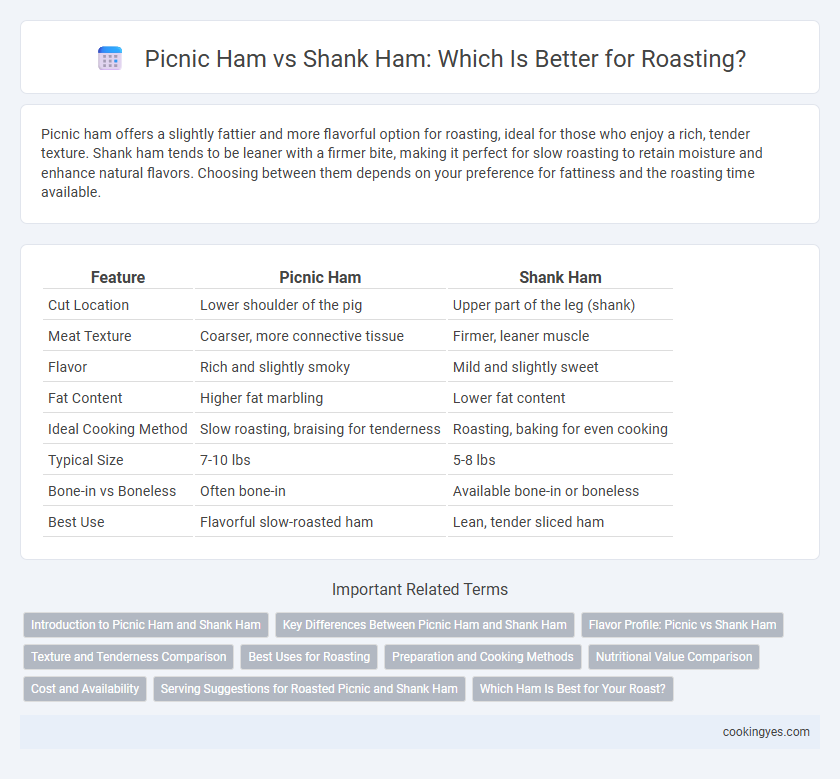Picnic ham offers a slightly fattier and more flavorful option for roasting, ideal for those who enjoy a rich, tender texture. Shank ham tends to be leaner with a firmer bite, making it perfect for slow roasting to retain moisture and enhance natural flavors. Choosing between them depends on your preference for fattiness and the roasting time available.
Table of Comparison
| Feature | Picnic Ham | Shank Ham |
|---|---|---|
| Cut Location | Lower shoulder of the pig | Upper part of the leg (shank) |
| Meat Texture | Coarser, more connective tissue | Firmer, leaner muscle |
| Flavor | Rich and slightly smoky | Mild and slightly sweet |
| Fat Content | Higher fat marbling | Lower fat content |
| Ideal Cooking Method | Slow roasting, braising for tenderness | Roasting, baking for even cooking |
| Typical Size | 7-10 lbs | 5-8 lbs |
| Bone-in vs Boneless | Often bone-in | Available bone-in or boneless |
| Best Use | Flavorful slow-roasted ham | Lean, tender sliced ham |
Introduction to Picnic Ham and Shank Ham
Picnic ham, derived from the lower shoulder of the pig, contains more connective tissue and fat, making it ideal for slow roasting to achieve tender, flavorful meat. Shank ham, sourced from the pig's lower leg, is leaner with denser muscle fibers, resulting in a firmer texture when roasted. Both are popular choices for roasting, with picnic ham offering richer moisture and shank ham providing a meatier bite.
Key Differences Between Picnic Ham and Shank Ham
Picnic ham, cut from the lower shoulder, contains more connective tissue and fat, making it ideal for slow roasting to achieve tender, flavorful meat. Shank ham, sourced from the upper leg, is leaner with less intramuscular fat, requiring careful roasting to prevent dryness but offering a firmer texture and richer pork flavor. The key differences in muscle composition and fat content influence cooking methods and the final taste profile of roasted ham.
Flavor Profile: Picnic vs Shank Ham
Picnic ham offers a richer, more robust flavor due to its higher fat content and marbling, which enhances moisture and tenderness during roasting. Shank ham features a leaner, slightly milder taste with a firmer texture, making it ideal for those who prefer a less fatty, meatier roast. The choice between picnic and shank ham influences the final flavor complexity and succulence of the roasted dish.
Texture and Tenderness Comparison
Picnic ham tends to have a coarser texture and slightly tougher meat due to higher connective tissue content, making it ideal for slow roasting to achieve tenderness. Shank ham features finer muscle fibers and less connective tissue, resulting in a naturally tender and moist texture that roasts more evenly. For optimal roasting, shank ham requires less cooking time while picnic ham benefits from prolonged slow roasting to break down toughness.
Best Uses for Roasting
Picnic ham offers a flavorful, slightly fattier option ideal for slow roasting and carving due to its tender texture. Shank ham, leaner and denser with a firmer bite, is better suited for roasting when you want a sliceable, less greasy finish. For roasting, picnic ham enhances richness and moisture, while shank ham provides a leaner, more uniform presentation.
Preparation and Cooking Methods
Picnic ham requires longer, slower cooking methods such as slow roasting or braising to break down its tougher muscle fibers, often needing a soak or brine before roasting to enhance moisture retention and flavor. Shank ham, being leaner and less fatty, benefits from careful roasting at moderate temperatures to prevent drying out, and often requires minimal preparation aside from scoring and seasoning. Both types demand internal temperature monitoring to reach 145degF for safe consumption while maintaining juiciness and texture.
Nutritional Value Comparison
Picnic ham contains slightly higher fat content and more calories compared to shank ham, making it richer but less lean for roasting purposes. Shank ham offers a higher protein percentage with lower fat, beneficial for those seeking a heart-healthy option. Both hams provide essential vitamins like B6 and B12, but shank ham generally delivers a better balance of nutrients for a nutritious roast.
Cost and Availability
Picnic ham is generally more affordable and widely available in grocery stores compared to shank ham, making it a cost-effective choice for roasting. Shank ham tends to have a higher price point due to its tenderness and traditional use in specialty dishes, but it can be less common in standard retail outlets. When budgeting and sourcing for a roast, picnic ham offers broader accessibility and better value without sacrificing flavor.
Serving Suggestions for Roasted Picnic and Shank Ham
Roasted picnic ham pairs well with classic sides like roasted vegetables, mashed potatoes, and tangy mustard glazes, enhancing its rich, slightly fattier flavor profile. Shank ham, with its denser texture, benefits from sweet accompaniments such as honey-glazed carrots or pineapple slices to balance its savory intensity. Both cuts serve excellently when thinly sliced for sandwiches or thick-cut alongside seasonal salads for hearty meals.
Which Ham Is Best for Your Roast?
Picnic ham, cut from the lower shoulder, offers a fattier texture and rich flavor ideal for slow roasting and braising, while shank ham from the leg is leaner with a firmer texture, making it better for a traditional roast. Choosing between picnic and shank ham depends on your preference for fat content and cooking time, as picnic ham requires longer cooking to break down connective tissue, whereas shank ham cooks faster and provides a more uniform slice. Consider the balance of flavor, tenderness, and recipe demands when selecting the best ham for your roast.
Picnic ham vs shank ham for roasting Infographic

 cookingyes.com
cookingyes.com